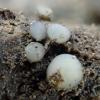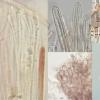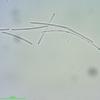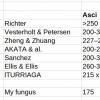
11-11-2025 20:16
Bohan JiaHi, lastly I have found these tiny yellow decayin

09-11-2025 13:20
Hello.A tiny ascomycete, appearing as erupting gra

08-11-2025 00:29
 Francois Guay
Francois Guay
I found this species in Quebec, Canada, on herbace

04-11-2025 09:07
Hello.A suspected Hymenoscyphus sprouting on a thi

04-11-2025 12:43
 Edvin Johannesen
Edvin Johannesen
Hi! One more found on old Populus tremula log in O
Vibrissea flavovirens?
Stefan Jakobsson,
08-07-2022 02:34
Can it be confirmed that this is V. flavovirens?
Hans-Otto Baral,
08-07-2022 08:39

Re : Vibrissea flavovirens?
I think the colour is not so important. Since I do not have an overniew on available measurements, I cannot easily say if such small measurements ever occurred, but I do not know a further species with these characters.
Stefan Jakobsson,
08-07-2022 11:49
Hans-Otto Baral,
09-07-2022 09:42

Re : Vibrissea flavovirens?
Thanks for this survey. In my key I wrote for flavovirens:
asci *260-343 x 6.5-8.8 µm
spores *125-195 x 1.2-1.8 µm
spore fragments *(27–)30-42(–51) µm
Ascus measurements in your table are probably mostly in dead state, but the differences to living asci are apparently not very high.
In the type of V. minima Velen. on Salix, which I restudied and considered a synonym, I found asci +154 x 4.8-5.3 and spore fragments 27-48 µm. So your spore fragments are a bit shorter than usual.
In a collection from Sheffield (HB 9520) I measured spores *125-134 µm long (like yours), breaking into 4 part spores of *27-38 x 1.3-1.6 µm, 4-celled (ascus length not measured).
In the case there is a continuum of measurements among collections, I suspect that living asci much shorter than 260 µm also occur.
Identities in the literature are perhaps not certain. E.g. Zheng & Zhuang 2017 do not mention the number of spore cells and fragments, but the spore photo suggests flavovirens indeed.




